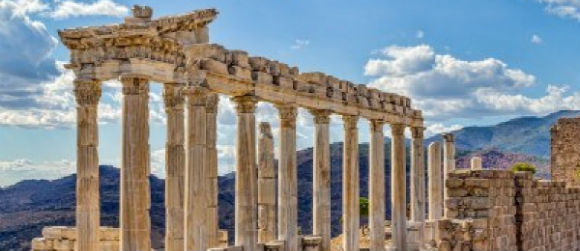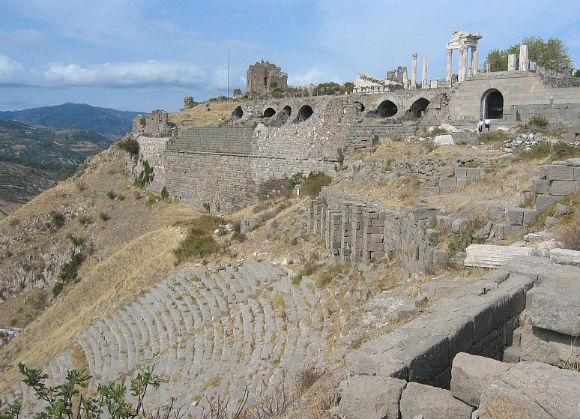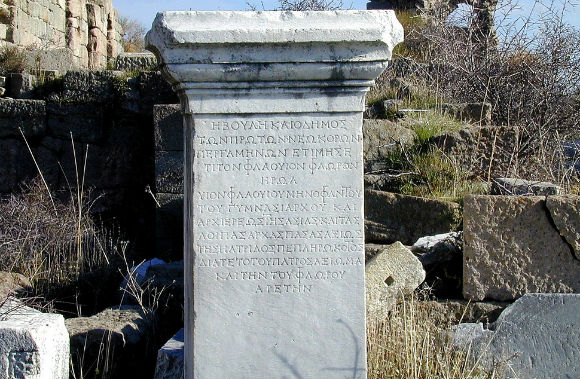The Acropolis of Pergamon was the site of the world’s second largest ancient library (after the library at Alexandria, Egypt). Eumenes II loved collecting books, and his library is said to have contained 200,000 books. At one point the rivalry between Alexandria and Pergamon became so intense that Egypt cut off its supply of papyrus to the city. Not to be deterred, Eumenes II challenged his scientists to find a replacement, and they did–pergamen, which is known as parchment in English. Parchment was derived from animal hides rather than pressed papyrus seeds and was more durable and could be written on both sides.
The Temple of Trajan is one of the best preserved structures still remaining on the Pergamon Acropolis. It was restored by the German Archaeological Institute. Scientists from the Institute excavated the entire site over many years, and many of the best artifacts are now contained in the Pergamon Museum of Berlin, Germany. I thought the most interesting structure on the Acropolis was the 10,000-seat theater, which is built into the hillside of the Acropolis and is one of the steepest in the world.
Those fascinated by Roman ruins could easily spend several hours at the Acropolis, especially if the weather is favorable. Our group had plenty of time to walk all over the site before riding the cable car back down to board our bus and drive to the Asclepion.
During the 350 years following the death of Alexander the Great (323 BC) until Pergamon (also spelled Pergamum) became a province of the Roman Empire (129 AD), it was one of the richest and important cities of the Middle East. The city reached its high point during the reign of King Eumenes II (197-159 BC).
Today, visitors can explore the historical remains and significant archaeological excavations at the Pergamon Acropolis, Red Basilica, and at the Asclepion (hospital complex), all of which is in the Turkish province of Izmir and only 16 miles from the Mediterranean Sea.
Located in downtown road to the Acropolis, the Red Basilica was built in the second century BC and was once a temple to the Egyptian God Serapis. In the Book of Revelations in the Christian Bible, St. John the Divine identified this basilica as the throne of the devil and one of the seven churches of the Apocalypse.
The Acropolis is accessed via a cable car, which was built just a few years ago. Previously, buses and cars drove a winding road to the summit, but now visitors park, pay a fee, and ride the cable car to the top. Once you exit the cable car, there’s a cafe and a few shops.
Walking around the ancient site of this important city’s acropolis is quite interesting, and the views of the surrounding countryside, the old Roman aqueducts, Pergamon and Asclepion are terrific.
This white stone at Pergamum with names inscribed reminds of Jesus’ words: “And to the angel of the church in Pergamos write…He that hath an ear, let him hear what the Spirit saith unto the churches; To him that overcometh will I give to eat of the hidden manna, and will give him a white stone, and in the stone a new name written, which no man knoweth saving he that receiveth it” (Rev 2:12, 17).
Acropolis of Pergamon,




You do not need to be a history buff to enjoy this historic ancient ruins because one can simply enjoy this place due to the amazing view it offers! You can choose to hike up and down or take the cable car to get to Pergamon,
Since it is a Roman city, the pillars, columns and architecture are similar to…
We caught a taxi from our campsite – Caravan Camping – to the gondola at the Acropolis and spent a very interesting couple of hours exploring this ancient archaeological site. We had read that we should take only a one way trip on the gondola and walk down. The gondola is fairly new and it cost TL10 for the two…
The city of Pergamon (locally known as Bergama) is such a sweet city. The people are so friendly. Even the security guard that had to tell us the Acropolis park was closing was very kind! And the sites are amazing. Be prepared to walk and make sure your camera is on hand!
Travelling up by cable car was wonderfull.I was amazed who they built it.The spectacular theatre on the hillside is a must to sit in. The renowned healing centre was very interesting. Our tour guide again had so much information to give us.See the famous libary and the alter of Zeus.
The views from here are amazing! They now have a lift to take groups to the top which works well. They are putting this back together…. so there is a lot of stuff laying around/ not standing. But the history, the old- ness, the ability to build these structures so long ago is overwhelming.
We spent the night in the…
It was a great feeling walking back in history through the ruins of the site. The underground tunnels rendered an amazing view. The great many stones and stairs made climbing a bit difficult, but there was a lot to check out and we managed everything. The Acropolis is very well maintained and is a great place to visit. We came…
After seeing so many amazing ruins in Turkey and Greece, I have to say I was underwhelmed by Bergama. It is the same price as Ephesus and Pamukkale/Heiropolis, but not nearly as interesting. If you're on your way from Canakkale to Izmir, I guess it is worth stopping for. Bergama sure does have a lot of inexpensive restaurants, so maybe…
I really enjoyed walking around the site and trying to remember my history lessons. Fortunately there are good information signs. But just enjoying the views and the archaeological remnants was enough to make it a memorable experience.
If you are in Western Turkey this site is definitely worth a visit. Although there are many ancient ruins in Turkey and Greece, this one is worth a detour simply for its beautiful setting although the site itself is also quite fascinating. The temple area is quite well restored. The theatre area is just stunning and likely to give you…
Definitely worth seeing. I cannot believe the way this site is preserved. You will be amazed. The walking is uneven at times.